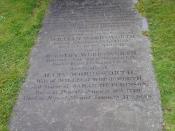John Keats and William Wordsworth ironically wrote two sonnets about the sonnet with contrasting attitudes. Both authors have different ideas and feelings about the constraints imposed on the poet by the sonnet form. Keats, although he feels negatively about the constraints imposed by the sonnet format, he writes the sonnet in his own creative unidentifiable form. Wordsworth however, tells the reader that he uses the format of the sonnet as a refuge and solace from "too much liberty." Both authors sonnets contrast in their attitude and form but also are similar in some of the techniques used.
One of the largest notable difference in the two sonnets is the form used; Keats used an unidentifiable form rather than the standard Shakespearean or Petrarchan form. Wordsworth uses an Italian rhyme scheme in his sonnet to convey his attitude that he does like the "Sonnet's scanty plot of ground." Keats use of an unidentifiable form further extends his attitude that even while being limited the poet can still let the "Muse be free."
Other contrasts between the poets and their poems is the use of allusions; Keats alludes to Andromeda, a Greek myth, and Wordsworth does not use allusions, however he does give examples that the reader can relate to.
Both Keats and Wordsworth use elaborate diction to convey the constraint and weight of the sonnets form. The diction in Keats sonnet especially gives the reader a feeling of the chains a poet is bound with in writing a sonnet. Wordsworth uses diction that helps to reader to understand the weight that is lifted from having too much liberty. Both poets create vivid images of the constraintment. Wordsworth uses the examples of the nuns and hermits to give an image of the boundaries that are set by the poem. Keats uses Greek...



Something missing!
I really could not understand a word. This is because the writer, unfortunately, overlooked the fact that we as readers do not know which sonnets he is talking about!!
To avoid such complications, it is advisable that a writer begins any essay or comment on a literary work by:
- stating the name of the work & its author.
- stating the literary period when it was written, and the country or region.
- giving a brief idea about what the work is about.
-finally u write what the question requires, or what u have in mind.
2 out of 2 people found this comment useful.